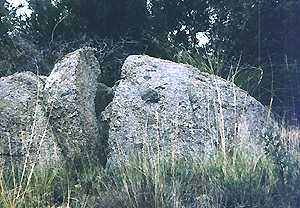|
WEATHERING
When rocks, especially igneous and metamorphic rocks are exposed at
the surface, either during eruptions or as a result of erosion, the combinations
of minerals which were stable under higher temperatures and pressures are
no longer in their original environment of formation. As they are exposed
to the highly reactive chemicals of the atmosphere and the surface environment,
they begin to change both physically and chemically into new combinations,
which are now stable in this new, low temperature, low pressure, surface
environment.
The sum total of these surface changes at the surface, including
changes in size and chemistry, is referred to as weathering. Those processes
which result in only a change in size are called physical or mechanical
weathering, and those which result in new chemical combinations or minerals
are called chemical weathering.
Physical (Mechanical) weathering

Frost wedged rock at Kitt Peak AZ (jk97) |
Physical weathering simply reduces
the size of rocks. This takes place in two ways: either inorganically or
by the action of living things. Virtually all rocks in the world have been
cracked, either by forces which acted upon them when the rocks were still
buried, or because of unloading, when the weight of overlying rocks has
been removed by erosion and the rocks then expand and crack. Water which
seeps into the ground fills these cracks. During cold spells, the water
freezes and expands, placing great stress on the rocks, and they break.
This process, called frost wedging, is most active in cold climates,
at high altitudes or latitudes. Less commonly, growth of crystals in cracks
can also cause rocks to break up. |
Living things also cause considerable damage. Plants put out extensive
networks of roots which penetrate cracks. As plant roots grow, they exerts
pressure on the surrounding materials and split them. Clams and other marine
organisms, drill holes into rocks. Finally, a visit to a strip mine, or
a journey along an interstate cut into the mountains should be enough to
convince anyone of the profound effects of human activity.
The net effect of physical weathering is the reduction in size of the
materials at the surface of the earth. Physical weathering has little effect
on the makeup of the materials themselves. However, physical weathering
promotes chemical weathering by increasing the surface area exposed to
the action of various chemicals. |

